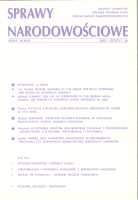Struktura narodowościowa mieszkańcow Polski w 1931 roku na podstawie deklarowanego języka traktowanego jako ojczysty
Ethnic Structure of Poland's Population in 1931 Based on the Declared Native Tongue
Author(s): Tomasz WysockiSubject(s): Cultural Essay, Political Essay, Societal Essay
Published by: Instytut Slawistyki Polskiej Akademii Nauk
Summary/Abstract: The objective of this paper is to examine the ethnic diversity of Poland's inter-war population. Despite my work being based on studies of statistical data, I have also inserted some comments from historians to help better understand the subject and accurately analyse Poland's demographic situation in the 1930s. The statistical database I have used for the purpose of this analysis is the results of the National Census of 9 December, 1931. Using relatively reliable numerical data obtained from the aforementioned Census, I have projected the ethnic structure of inter-war society in Poland, with the key criterion being the declared native language, its distribution in individual counties, urbanisation level, and gender. Poland between World Wars I and II was a multinational state. More then 30% of the Polish society was not of Polish origin. The largest groups of national minorities were represented by: Ukrainians, Jews, Byelorussians and Germans. Quite large ethnic-language group was “locals”, that means people with unformed national awareness, resulting from census 1931 distinguished only in Polesie. The central and western provinces were more nationally homogeneous than the eastern provinces. The most homogeneous was Silesia, and the least – Polesie. Most of Jews and Germans lived on the ethnic Polish land, whereas in the west borderland lived populations of the other national minorities. Jews constituted the most urbanized national group that lived in our country between the two World Wars. Jews, Russians and Germans were more urbanized than the Polish. Less urbanized were the Slavic minorities (so-called “locals,” Byelorussians, Ukrainians and Ruthenians) and the Lithuanians. The most feminized national groups in II Rzeczpospolita were Germans and Russians, and the least – Ukrainians and Czechs.
Journal: Sprawy Narodowościowe
- Issue Year: 2005
- Issue No: 26
- Page Range: 29-55
- Page Count: 27
- Language: Polish

